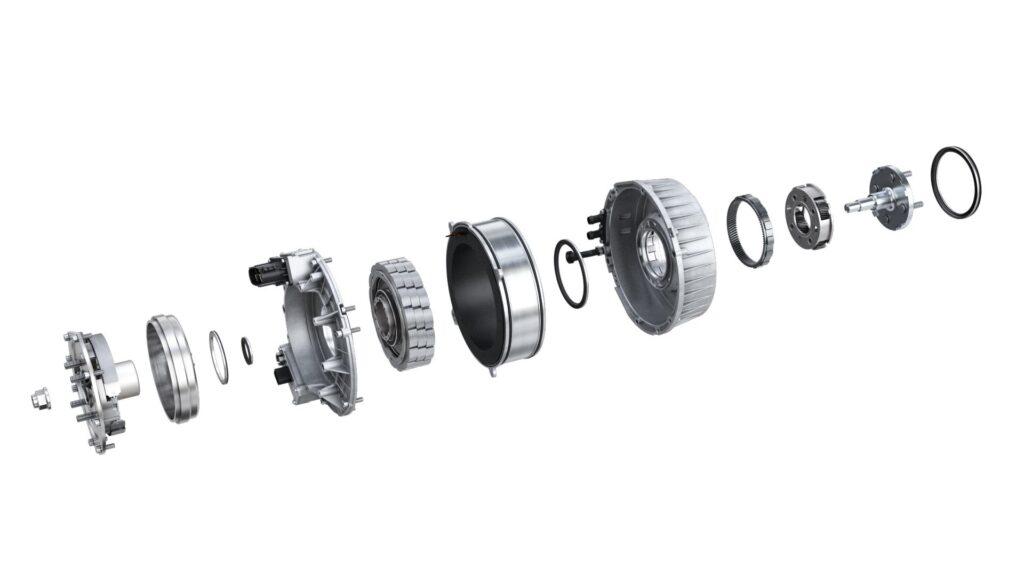
With electrification, good things come in threes, it seems. No less than three manufacturers of compact municipal vehicles are gearing up to incorporate high-efficiency electric wheel hub motors made by Schaeffler into their production lines in the coming months. Fully electrified, their road sweepers, vans, and snowplow vehicles will operate with zero local CO2 emissions, leading to improved air quality in urban areas. “Schaeffler is reinventing the drive systems used in small, lightweight electric utility vehicles in our inner cities,” said Matthias Zink, Schaeffler’s CEO Automotive Technologies. The defining feature of the new wheel hub motors is that all the components needed for propulsion and braking are integrated directly into the wheel rim, rather than being positioned centrally or mounted on the drive axles. This architecture saves space and makes the vehicles much more agile and maneuverable in city traffic. Utility vehicles powered by these low-noise, fully electric motors are very quiet to operate, resulting in reduced sound pollution in pedestrian areas and on city streets. They can also be operated for extended hours in residential areas because the disturbance to residents is so much less.
One of the first companies to be launching a multifunction vehicle comprising Schaeffler wheel hub motor technology onto the market this year is Jungo. Jungo and Schaeffler have been partnering to tailor the drive technology to the specific everyday requirements of commercial street sweeping. “The electric in-wheel motors and braking technology eliminates the need for oil changes and greatly enhances our vehicles’ performance in terms of efficiency, power-to-weight ratio, safety, handling, and braking reliability,” said Jungo founder and CEO Nicolas Jungo.
Efficient solution for a wide range of inner-city and mobility scenarios Schaeffler’s wheel hub motors have a broad range of inner-city mobile machinery applications, including street sweeping, snow clearing, and waste collection. “In this vehicle segment, as in others, the question is: what’s the fastest and most efficient way to reduce CO2 emissions? And the answer to that question is electrification,” said Dr. Jochen Schröder, head of E-Mobility at Schaeffler. This new drive technology opens up a new and steadily growing market for Schaeffler. The company aims to see its wheel hub motors used in more and more utility and service vehicles in towns and cities, on factory campuses, and at logistics centers, ports, airports, and large parking facilities. These types of vehicles tend to be operated on set routes, so they are a good fit for the fixed ranges and predictable charging times of electric drives. Another key benefit for vehicle operators is that the wheel hub motors have long-life, low-maintenance wheel bearings and gearboxes.
Schaeffler’s fully electric wheel hub motors have a unique architecture in which the electric motor (stator and rotor), gearbox, and mechanical friction brake are arranged around the wheel bearing inside the rim. This compact design envelope frees up space elsewhere in the vehicle – for the battery or cargo stowage, for example. It also gives vehicle manufacturers greater design freedom, allowing them to develop a wide range of mobility formats, including rolling chassis solutions. “Our highly integrated electric wheel hub motors also improve vehicle maneuverability, which is a key prerequisite for automated driving,” said Jochen Schröder.
In-wheel motor saves space and improves driving dynamics The wheel hub motor, including the gearbox, is very compact, fitting inside a 14-inch rim. The inverter, on the other hand, is not integrated, and can be accommodated anywhere in the vehicle. A single inverter controls one or two wheel hub motors, depending on the use scenario. The motor’s power output is scalable, depending on the application, ranging from 7 kW to 26 kW (nominal) and peaking at 60 kW for short bursts. The torque generated by the electric motor is transmitted via the gearbox directly to the wheel. This direct transmission reduces energy loss, making the drive highly efficient. Another key benefit is that torque and direction of rotation are controlled individually for each wheel, resulting in an all-wheel drive vehicle that can handle hills with consummate ease, even in winter road conditions. Schaeffler currently develops wheel hub motors for 48 V and 400 V applications and is exploring the possibility of higher voltages.
Schaeffler Group – We pioneer motion
As a leading global supplier to the automotive and industrial sectors, the Schaeffler Group has been driving forward groundbreaking inventions and developments in the fields of motion and mobility for over 75 years. With innovative technologies, products, and services for electric mobility, CO₂-efficient drives, Industry 4.0, digitalization, and renewable energies, the company is a reliable partner for making motion and mobility more efficient, intelligent, and sustainable. The technology company manufactures high-precision components and systems for powertrain and chassis applications as well as rolling and plain bearing solutions for a large number of industrial applications. The Schaeffler Group generated sales of approximately EUR 13.9 billion in 2021. With around 83,000 employees, Schaeffler is one of the world’s largest family companies. With more than 1,800 patent applications in 2021, Schaeffler is Germany’s third most innovative company according to the DPMA (German Patent and Trademark Office).











More Stories
Click Shield from MIKROE simplifies integration of Arduino Portenta with over 1600 Click boards
Optimizing Mid-Power Silicon MOSFETs for Automotive Applications
Paolo Pininfarina named the 2024 Laureate of The American Prize for Design